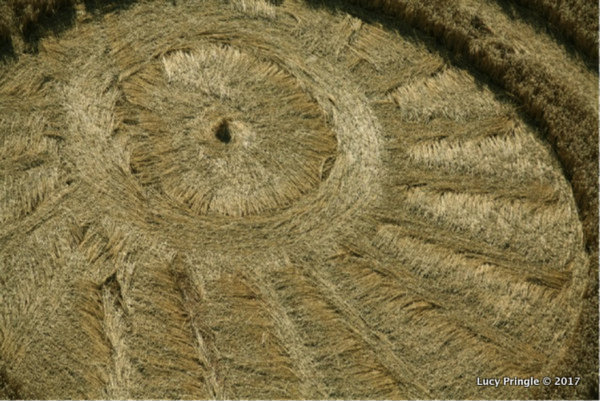Contact Lucy to share a helicopter flight. See the circles, the surrounding countryside and archaeological sites. My Crop Circle Tours and private visits to Stonehenge.
Yet again, as I write this, the ground outside is white with frost, and snow is forecast; and whilst I am wearing several layers of clothes, it is hard to imagine being in a short-sleeved cotton shirt and still feeling hot with the sun beating down on my arms!!! What a glorious thought!!!
All seasons have their magic, and the first signs of spring are quite one of the most exciting, and it is small wonder that our ancient forebears built Stonehenge to commemorate the winter solstice in expectation of fruitful months ahead. The snowdrops have put on a really splendid display - waving their heads in exuberant joy at being the first to show their presence. The hazel tree with its yellow catkins (Corylus avellana) is also prominent, and the crocus will soon follow. The days are getting longer and soon the sap will be rising in the trees, and before we know it, banks of primroses will be gracing the grass verges of our narrow country lanes.
Gods of old
2016 started in a modest way with two circles both close to Avebury, Wiltshire; one under the Cherhill chalk white horse and the second lying at Waden Hill between Silbury Hill and Avebury.
Waden Hill has a fascinating history and is part of ancient sites all around that particular area, such as Avebury and West Kennet, Long Barrow etc., which in the olden days of long ago, in the time of our forefathers, would probably have been called 'Woden Hill' after the Norse God, who in Germanic mythology, derived from the Norse God Odin - a widely revered god. He seemed to represent, and be associated with, a myriad of characters such as: healing; death; royalty; the gallows; knowledge; battle; sorcery; poetry; frenzy; and the runic alphabet; and was the husband of the goddess Frigg.

Waden Hill lies in between the magnificent Silbury Hill and Avebury complex.
The vivid yellow flowers of the oil seed rape (canola) plant had faded, and when flying over the fields they appeared as a pale bluish colour.

The next crop to act as host to the circles is barley. It is a deliciously soft and seductive crop, gently brushing against one's legs as one walks down the tramlines - the bare lines in the fields running horizontally or vertically - used by the farmers to make sowing and spraying easier as a point of entry.
After a long dry and chilly period, followed by days of much needed rain, a wonderful goddess figure appears earlier on the 22nd May at Cerne Abbas, close to famous male fertility symbol. For the Goddess figure to arrive close by, seems a special balancing-up of the two energies in the landscape.


Cerne Abbas is close to the little village of Ansty where the memorable circle appeared in 2016, and which drew visitors from all over the world. Sadly, when I flew over it, it was so badly worn that it was almost impossible to photograph. I could see that the crop had not been a very dense one to start with and had become easily damaged.


The spectacular photograph below was taken by aerial photographer Jane Barford, who very kindly allowed me to include it.

May was a busy month with several circles appearing. Nestling directly below the Milk Hill chalk white horse, the circle reported on the 25th May was a very crisp pattern and looked wonderfully comfortable resting in the field of barley beneath its guardian above.
I was fortunate in flying over it almost immediately, taking two friends with me; as the helicopter can take the pilot plus three passengers. Flying over the countryside always gives my passengers and me an enormous thrill, and my heart gladdens to see an unspoilt landscape where cattle and sheep graze, and crops are grown for our ever increasing demand for food. In addition, seeing the hills, sacred mounds, castles and winding rivers is an extra bonus. Soon the fields would be glistening with red poppies adding a touch of colour to the landscape. It was the artist L.S Lowry who always included a speck of red in all his paintings and it is extraordinary how that little speck can bring the whole painting to life. On a more mundane level, I love counting the number of houses that have swimming pools!


Usually any circle found along the Pewsey Vale is harvested out immediately, so it was all credit to Brian Reid, the kind farmer who has kept it in. Admittedly there are not many people around at that early part of the season, so the likelihood of his crop being damaged was hopefully slight. I do hope so anyway. I did go in the first day it appeared with Hugh Newman of Megalithomania and his mother Meg, who returned to the car as it was a long walk. On entering the formation I was struck by the quality of the crop as it felt almost as bouncy as when I was walking on a newly laid and very thick Wilton carpet of the best quality.

Whereas the majority of the crop seemed undamaged I did notice several tread marks from the soles of shoes left by people where they had trodden on the crop. I was wearing a pair of canvas shoes and I found it interesting to note that when I stood on the crop, my soles left no mark (I had no treads on the bottom of my shoes, also I only weight about 108 lbs (49 kilos). I do know that a friend of mine had been in before me with a colleague so that could explain the tread marks. But I will never know!
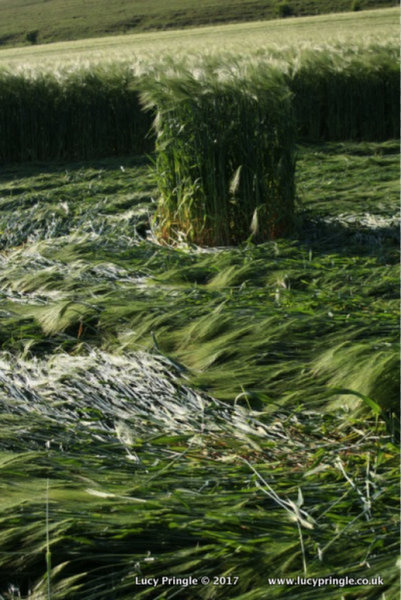
I examined as much as I could for further evidence but ran out of time. Many is the time when I am asked to pronounce on how many circles are man-made and how many are genuine - this was an excellent example of the many times I have to say that 'I have no opinion' - in other words I do not know and cannot make a judgement as I was not the first person into the formation.
Don’t forget your wellies!
As explained in my general letter, this circle was the back drop to a memorable day spent when taking a most lovely and charming family on a private tour.
Cardiologist Mark, his lovely wife and perinatologist, Karen and their two wonderful children Gabriel (16) and Anna (12). They had written to me in November 2016 saying that they would very much like me to take their family on a private tour round the circles etc. in the summer 2017. After lots of correspondence, it was planned that I would take them round any available crop circles, and if there weren’t any we could visit we would go round the ancient sacred stone sites in the area such as Avebury stone complex, West Kennet Long Barrow (the oldest), Silbury Hill etc. I planned a helicopter flight (requiring two helicopters to take us all) to fly over the circles and ancient sites. To finish the day I was really lucky to obtain a private entry evening visit to Stonehenge. It all sounded wonderful and we met at Silbury Hill car park - but - the weather decided otherwise. Such are the perils of living on an island — the weather is mercurial. It was raining when we met and it rained consistently ALL DAY. Were they daunted - not one little bit! They were as gallant as any knights of old. Visiting a crop circle was the top of Gabriel’s list so we started off by walking up the grass track to circle below the Milk White Horse at Alton Barnes, Wiltshire. We could see the circle quite clearly as we walked towards along the path and marks in the field where people had trampled over the crop to reach it. Having visited it previously on the day it first appeared, I knew the entry point into the field which would lead directly down a tramline into the circle, thereby not damaging the crop at all. Into the field we went and not only was the circle no longer visible, the landscape had somehow changed due to the recent incessant rain and heavy winds which had caused considerable wind damage knocking the crop flat where I thought the entry tramline should be. However, I decided we should walk further along the vertical tramline and we entered a horizontal tramline only to find it was the wrong one. Undaunted we tried another—another wild goose chase.
As you can image by that time we were all soaking wet, having taken on the water from the heavily water laden barley seed heads as we walked down the tramlines. In addition, the plants had closed together and whereas the tram line was still there beneath our feet, we had to ease our way through the crop which was so high that it came to Anna’s neck - 'would anyone like to capitulate?', I asked. Not a bit of it, the whole family were game to last and such was the joy when we finally found it, having caused no damage on the way (except to ourselves), it made our sterling efforts all worthwhile. Anna had said she was freezing but by the time we had walked back to the cars, she said 'I am fine; I can’t feel my body at all now!' What a marvellous child, she will go far in life. 'A possible out of body experience', I joked!!!
We had booked to have lunch close by but it was quite obvious that we couldn’t possibly continue soaked to the skin as we all were wearing heavily wet clothes, so we drove back to Silbury Hill to collect my car before continuing to the hotel in Salisbury where the Alkire’s were staying. As I took my Wellington boots off, at least a pint of water poured out of each of them!!! Who would like to come on a private tour with me in 2018???!!!

Karen very kindly lent me a change of clothes. Oh the joy of being warm and dry again! Our never diminished spirits rose higher during lunch only to be dashed as news came from our plot that flying was out of the question due to the very gusty high winds and wet weather.
Close by was Old Sarum. Still completely unfazed we went in and wandered around the old ruins — IT WAS STILL RAINING!!!
We are told that Old Sarum is the site of the earliest settlement of Salisbury in England. Located on a hill about 2 miles (3 km) north of modern Salisbury near the A345, the settlement appears in some of the earliest records in the country. It is an English Heritage property and is open to the public.
The great monoliths of Stonehenge and Avebury were erected nearby and indications of prehistoric settlement have been discovered from as early as 3000 BC. An Iron Age hill fort was erected around 400 BC, controlling the intersection of two native trade paths and the Hampshire Avon. The site continued to be occupied during the Roman period, when the paths became roads. The Saxons took the British fort in the 6th century and later used it as a stronghold against marauding Vikings. The Normans constructed a motte and bailey castle, a stone curtain wall, and a great cathedral. A royal palace was built within the castle for King Henry I and was subsequently used by Plantagenet monarchs. This heyday of the settlement lasted for around 300 years until disputes between the Wiltshire sheriff and the Salisbury bishop finally led to the removal of the church into the nearby plain. As New Salisbury grew up around the construction site for the new cathedral in the early 13th century, the buildings of Old Sarum were dismantled for stone and the old town dwindled. Its long-neglected castle was abandoned by Edward II in 1322 and sold by Henry VIII in 1514.
Although the settlement was effectively uninhabited, its landowners continued to have parliamentary representation into the 19th century, making it the most notorious of the rotten boroughs that existed before the Reform Act of 1832. Most famously, Old Sarum served as a pocket borough of the Pitt family.
Steadily becoming wet again we drove to Stonehenge Visitors Centre and visited the really excellent exhibition and also had the luxury of a cup of warm tea or coffee in its large café. At the appointed time we went to the stones by coach and guess what — it was STILL RAINING and our second set of clothes were as wet through as the first!
Never once was there a moan or grumble of any sort and if there were a medal for 'Croppie' endurance and gallantry, they would all have received one with my blessings. What a joy and how I hugged them for their marvellous spirit and wonderful good humour. They are truly an inspirational family!
However, you will be glad to hear that this story DOES have a happy ending as the next day the rain had been banished and the sun shone, allowing us to fly over the circles and Avebury, AND I was able to return Karen’s clothes, now dry!
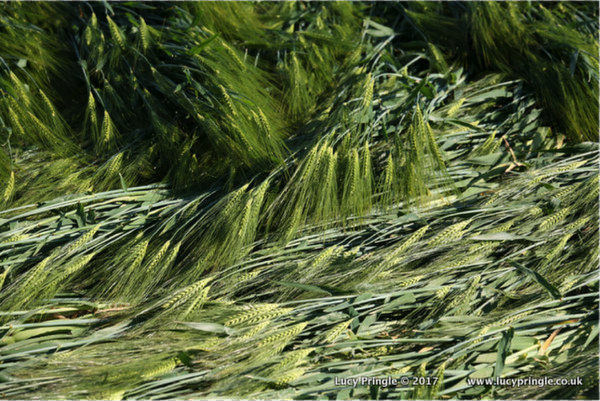
Look over the hedge
On the 28 May three circles all different shapes and sizes, were reported at Summers Lane, Nr Broad Hinton, Wiltshire - two in one field and a star shaped one in the adjacent field. Only separated by a hedge, two contained interesting features worth noting.


The tracery work on the larger circular one was very fine, consisting of four concentric rings with a combination of larger and smaller floral patterns interlacing the concentric circles.


If you look closely at the above picture you will see that there are no connecting lines between any of the circles (15 medium sized ones and 60 smaller ones) in the star shaped event. This is a good sign as walking between the crop leaves a visible trail indicating possible human or animal evidence or involvement.
Following close it their heels on the 30th of May came the beautiful and complex six-petaled floral pattern at Fonthill Down, Nr. Chicklade, Wiltshire. The wonderful picture below was taken by Mat Stainton, who most generously allowed me to use them as a front cover to my wonderful 2018 calendar.

June was a strangely quiet month with two circles appearing in Crézancy-en-Sancerre, France, Viex Lixheim, near Sarrebourg, Moselle, France and one in Delley-Portalban, Broye, Canton Fribourg, Switzerland.
Back to school?
On 4 June a circle with 3 sets of six circles of diminishing size and resembling 'bubble wrap' came to rest at Woolstone Hill, Nr Ashbury, Oxfordshire. Woolstone is mentioned in the Domesday Book of 1086 and records that the Bishop of Winchester held an estate at Woolstone assessed at ten hides. Its income was used to support the Benedictine St. Swithun's Priory at Winchester. This academic school still flourishes today close to where I live.
Woolstone Hill is also part of an ancient landscape and lying close by you will find the oldest of our chalk White Horses, the Uffington White Horse. To me it resembles a Henry Moore sculpture. It has clearly changed over the years and there is some debate about it's original shape; could it have started life as a dragon? Close by we have Wayland's Smithy which is an atmospheric historic site about a mile's walk along the Ridgeway from the Uffington White Horse. It has a Neolithic chambered long barrow, once believed to have been the home of Wayland, the Saxon god of metal working.



Closer to home
Not to be out done, Hampshire, which in the late 1980’s and early 1990’s welcomed an abundance of crop circles, hosted a marvellous circle which appeared high up above Winchester on the A272. Nestling in the fields it was not visible from the road. Another couple from America had taken a private tour with me the previous day and we had flown over the circle, so I agreed to meet them the following morning and took them round the circle on foot. They were overjoyed; it is wonderfully exciting flying over the circles but quite another thing to be able to actually visit them and go right inside and feel the magic. The profuse wild flowers were at their peak and the peaceful countryside of rolling fields was looking breathtaking. A wonderful morning!


More friends, who were so excited to be up in the air sharing the helicopter with me, flew with me to Dorset over the newly arrived circle at Target Wood, Nr Badbury Rings, resembling the Sephirothic Tree, the Six-pointed Star, the Unicursal hexagram. We flew back via Stonehenge so that they could see the stones from the air. They look ridiculously small in comparison to seeing them on the ground. It was a marvellously warm evening and I didn’t even need a jacket. Inside the helicopter at about a height of 1000 feet (303m), it was still 25 degrees!

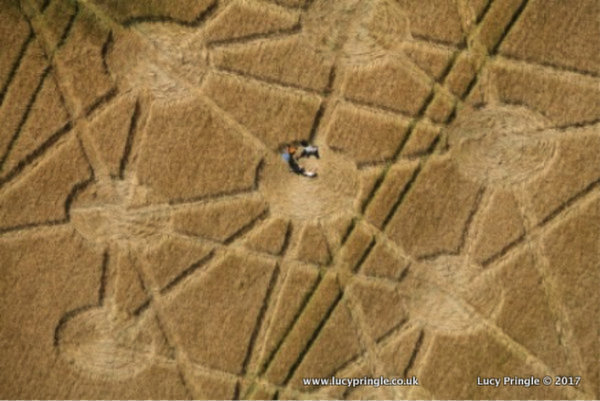

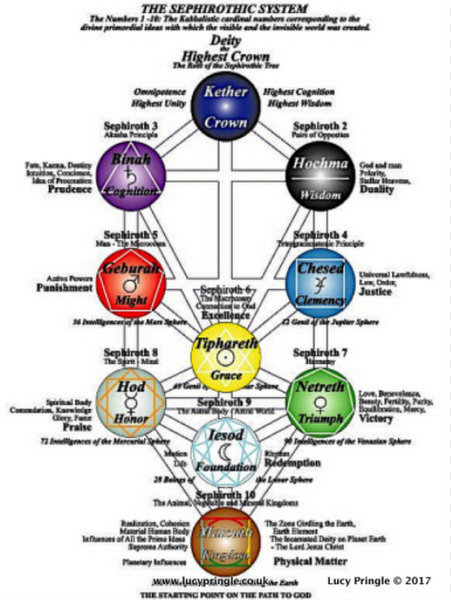
Ancient England from the air
The Isle of Albion is full of little known or visited ancient places and, as so often happens, flying over the countryside one can suddenly see some of these wonders. On the way to Dorset we flew over a round barrow with a small and ancient church perched in the centre. On returning home and further research it turned out to be Knowlton Norman Church owned by English Heritage. That whole area is one where you will find many other barrows or burial mounds and ditches in the vicinity; also many henges. In fact it boasts of having one of the greatest concentration of these ancient earth works in Dorset including the prehistoric and later archaeological remains surviving in this area of chalkland, known as Cranborne Chase, once used as a royal hunting ground from at least Norman times, which meant that land use was strictly controlled.
The clump of trees 60 metres (200 feet) to the east of Church Henge marks the enormous Great Barrow, the largest individual barrow in the county. Many other barrows and ring-ditches survive within a one-mile radius. Stretching away to the north-west, for example, is the Dorset Cursus, twin banks of chalk about 2 metres (6 feet) high running for over 9km (6 miles), defining another zone in this ceremonial landscape.

In Anglo-Saxon times, people were buried close to the Great Barrow. Then in the 12th century, uniquely among henge monuments, a church was built within Church Henge (hence its name), serving a now vanished community. This subsequent use explains the good state of preservation of this henge compared with that of the other two.
Covered in vegetation until the 1960s, the church has a reputation for being haunted.
Another story, dating from the 19th century, relates how the ruination of the church came about after its bell had been stolen by the Devil and flung into a nearby river, from which it could not be pulled out. An alternative tale involves theft by humans that was foiled by witchcraft.
The church was abandoned in the 18th century, about the same time that the antiquary William Stukeley (1687–1765) recounted a local tale that Knowlton had once been an old city; and that strangers had come out of their way on purpose to see it and that ruins and foundations were there.
Spot the spot
After quite a busy June, the 1st of July produced a circle at Boreham Wood that we later used for our scientific research day tests. It lay just inside the hedge hidden from the lane between Marlborough and Alton Barnes but visible coming from Alton Barnes.


Unfortunately, it was quite old when we conducted our tests. Another circle had appeared north of Swindon the previous day, but the farmer could not make up his mind if was going to allow people to visit it or not. In the event he did, but not until we were already in the Boreham Wood circle and had set up all our equipment. Hopefully, next year we will have a fresher circle available in the vicinity.

Scientist Paul Gerry from the Neurological department of the Devon and Exeter Hospital drove from Devon and Hazel Drummond, and an Asyra expert joined us having driven all the way down from Manchester. Parkinson sufferer and long time participant Gill Puttick came with us, as did Linda Daubney with Essential Tremor, plus other researchers. As always we conducted our first control tests at Avebury Study Centre. An extra experiment was included as ancient site and crop circle researcher and tour guide Glen Broughton told me about a particularly energetic place at Avebury in the south quadrant where the obelisk once stood. He mentioned that it was found to be especially active early in the morning - so on the spur of the moment, as we already in Avebury, I suggested that several people might like to conduct additional research. I am a firm believer that so many seemingly diverse areas of research have a common denominator.
Sensitive Mona da Silva found a spot similar to the one she had discovered in the Savanake crop circle in 2014 on which she could not keep her balance and kept being thrown off. Fascinated, I had followed her later and after a bit she found the exact spot (no mean achievement in a 200 ft. diameter circle). Was it really happening? I stepped on to it and was immediately rocked backwards a couple of steps. I tried it several times with exactly the same result.
Standing where Mona was standing, I found that yet again the identically same thing was happening to me where the Avebury obelisk once stood.
We then proceeded to the Boreham Wood crop circle. I had visited the circle twice before and found that I felt most uncomfortable and unwell except for just the area where I was comfortable - the rest of the circle was unpleasant. Hazel Drummond is extremely sensitive and being the first person in the circle automatically and luckily made her way to the one 'good' place!

Paul Gerry’s experiments consisted of:
1) Physical - measurement of tapping and rhythm
2) Cognitive- accuracy in choosing colour bars 3) Voice strength reading a sentence
4) Tremor frequently and variability.
I've printed out a table for each person so can draw conclusions easier than before.
Again this year we were interested in the possible effect of the crop circle energies on Parkinson’s Disease (PD) symptoms.
PD is much more than a motor disorder - tremor, slowness, stiffness are only part of the picture. Non-motor symptoms affect cognition which is the ability to process information and apply knowledge.
Using PD designed apps on an iPhone the following tests were applied:-
1) Tremor frequency and magnitude (motor function) using the gyro-function on the phone.

2) Physical test – The number of a finger taps in a given time is a proven method for evaluating overall nervous system health.

3) Cognitive test – tapping matching colours ignoring the colour words. This evaluates 'thinking on your feet' with quick decision making

4) Voice Analysis – Dynamic range (maximum loudness and the normal (average) speaking volume) – In PD the dynamic range decreases.
Results


Results Linda’s values are illustrated 10 times smaller. Interestingly they are the only ones that decreased.
Physical

Cognitive Test

Voice test


Highest level was in the Control Room due to electrical cabling. No significant different between inside the circle and at the edge of the field.
Second control tests were then conducted outside the circle.
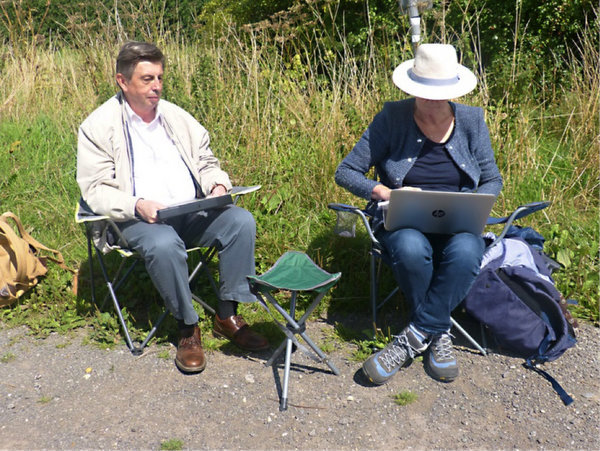
A most welcome addition was Hugues Delahayes with his electrostatic meter. Physicist Andrew King also brought his electrostatic meter so they were able to compare results.
The results below from Delahayes show the ratio results between the three different locations.

'Please find attached a spreadsheet with the results of the electrostatic experiments as requested. I estimate the voltage per graduation to be about 3 millivolts which gives the attached results. For your information, electrostatic variations were detected by the DRG at Knowlton (Church) Henge, some years ago.'
Hughes is acting as the antenna and as I understand it, is picking up the telluric energy, the electric charges that run through the land and sea and which vary in strength/energy at certain spots especially nodal cross over points.


Hazel Drummond's results were interesting:
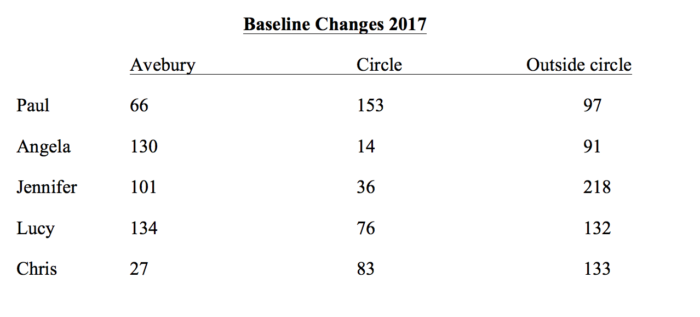
Taking the norm as 50, after testing a range of 35 items such as kidneys, heart, lungs, liver etc, the numbers shown above relate to the noticeable changes in 5 out of 9 people from tests conducted at Avebury, in the circle and outside the circle. The lower number indicating the best results.
It is interesting to note that the three females show significantly beneficial results inside the circle as opposed to before or after.
Wobbly Legs and Mended Watches
After her visit to the circle Hazel Drummond reported: 'We went into a circle which had appeared quite a few weeks before our visit so I thought that the energies were going to be quite weak - as did everyone else. So I was very surprised when I found that my legs were feeling heavy and weak as soon as we came near to the circle. For some of the way in we had to go against the flow of it and I found it really tiring and difficult to do. I also had an odd feeling in my head. A sort of pressure and fuzzy feeling. When in the circle we found a place to sit that felt good. I came back to feeling my usual self and could quite easily have stayed there for many hours. However, when I walked around the circle later there were areas that were very hard to walk through and made me feel quite dizzy. I was very tired for the rest of that day and the next but otherwise no after effects.'
Gill Puttick: 'We are so lucky with the weather on our trips out. I didn't feel much in the circle except for a thick head.
Monday Morning I was so sleepy I had my breakfast, next thing I woke up not knowing what day it was.'
Angie Kibble: 'All I can add is how heavy my legs felt walking against the energy flow into the circle. Once we got to the spot where the tests were carried out I lay down for some minutes and enjoyed the very uplifting energies there. When I walked further into the circle there were some parts of it that made me feel rather sick, a kind of heaviness in the pit of my stomach, but the circle energies were not consistently one or the other, if that makes sense.'
Linda Daubney:
'Just as I was leaving home to attend Lucy’s Scientific Day I stuffed my very old work watch into my handbag to take with me.
I had had this not very expensive Lorus battery watch since the mid 1990s. I bought it for work because it had a very clear face and was easy to read. It served me well and I used it until I was given a very pretty silver watch.
The work watch went into a drawer and there it stayed until my partner’s very expensive watch became unreliable and the Lorus was brought into service. It was still running and kept very good time. My partner used it until he finally bought a new watch, so the Lorus went back into the drawer.
A couple of years later the winder on my silver watch disintegrated and it could not be repaired so I brought out the faithful Lorus but it had stopped. As no one could remember having the battery replaced I had a new one put in but the watch became unreliable and, in spite of being inspected and the battery checked, it was not usable.
I was given a new watch for my birthday.
The Lorus was sitting on the kitchen table waiting for me to throw out what I regarded as a very faithful servant. Very difficult. So I took it with me to the Scientific Day.
I forgot all about it until we made an unscheduled visit to the South Quadrant at Avebury. Hunting for a tissue in my bag I pulled out the watch which was not running. I sat it on one of the original stones of the south quadrant for a short time while we watched the dowsing and other experiments going on.
When it was time to go to the circle I picked up the watch and the second hand was sweeping the dial. This was not unusual. Every now and again, if encouraged to start, it would run for a while but it always stopped not long afterwards. However, I put it right and stuck it back in my handbag. I then forgot it until I got home and turned out my handbag.
There was the Lorus still running and telling the correct time. That was July 6th, 2017. It is now February 2018, and it is still running and telling the correct time.
I shall be keeping the watch.'
Christopher Weeks who on a regular basis, takes an extraordinary amount of exercise running, fencing, cycling etc.:
'Walking towards the circle in the field about 150 feet away from it I had an uneasy pulse in the abdomen followed by and irregular heartbeat, when I entered the circle I had an instant headache with pressure behind the eyes, I found no discernible energy but found various spots that I had waves of nausea. I felt very unbalanced and had a lack of coordination. Also had a slight Gout type of twinge (which happily went) I noted that a lot of people had done things to the circle which I feel had not helped I.e., finding a rune in the centre of the standing twisted crop.
The nausea and the lack of coordination cleared when leaving the circle but the headache remained for the rest of the day clearing the next morning. It should be noted that over the 2 days prior to going in the circle I had cycled 100 plus miles on the Southdown’s way.'
Permission Granted
Other circles that need to be mentioned were the Eternal Knot event at Battlesbury Hill, Near Warminster, Wiltshire on the 5 July and which lay just inside the military zone making it necessary to obtain military clearance before we could fly over it.
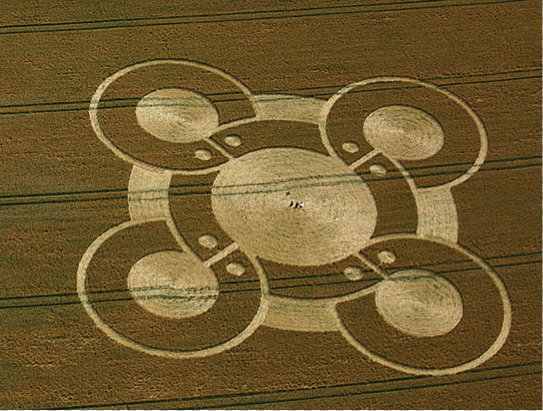
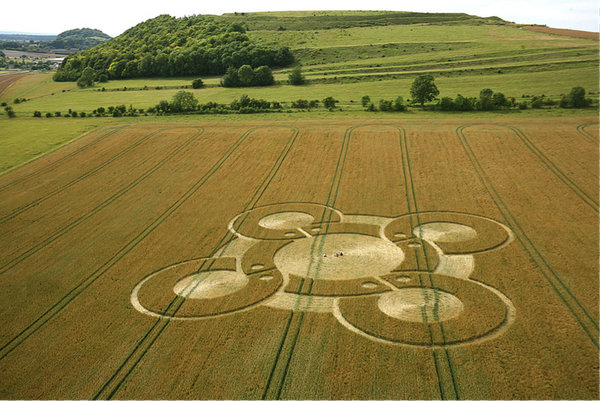
Next came the complicated circle at Hackpen Hill Near Broad Hinton, Wiltshire adjacent to the famous chalk white horse etched into the hill side. Reported 8th July. It was one of the later ones in barley. As you can see it contained a complex formation of scalloped edges with two arcs containing semi-circles at either side of the each scalloped apex. A central cube has 12 radiating triangles. The two pictures below illustrate how very different a circle can look when taken from varying angles. I always take two crop circle tours each year which are immensely popular. On the first tour we visited this circle with permission from James Hussey the farmer, who always generously opens his fields to the public who are only too happy to contribute to the splendid charity set up in memory of this lovely wife Gill who sadly died after a long and brave battle with cancer. The charity is to raise money to equip a breast screening radiotherapy unit to be built on the site at the Great Western Hospital, Swindon, as the closest unit was in Oxford and for Gill and others to have to travel many hours for a daily treatment lasting a few minutes each time over a period of six weeks was altogether too exhausting and draining. Over £800.00 has already been raised towards the target of £2.9 million having already raised £750,000. This is a really splendid and worthwhile charity worthy of support. The charity, Brighter Futures, told me that to date 'we have received support from companies in Swindon such as Sainsbury’s Stratton and TE Connectivity'. Staff at other companies including Corporate Events, Arval, Jury’s Hotel, Nationwide and Santander have all supported the appeal by fundraising for us.
Many schools, nurseries and centres for learning have also adopted us as their chosen charity for the year, as have many other smaller organisations such as churches, local groups and WI’s and Rotary Groups. To find out the latest news about what we are doing with the help of local people visit our website on www.brighterfuturesgwh.nhs.uk
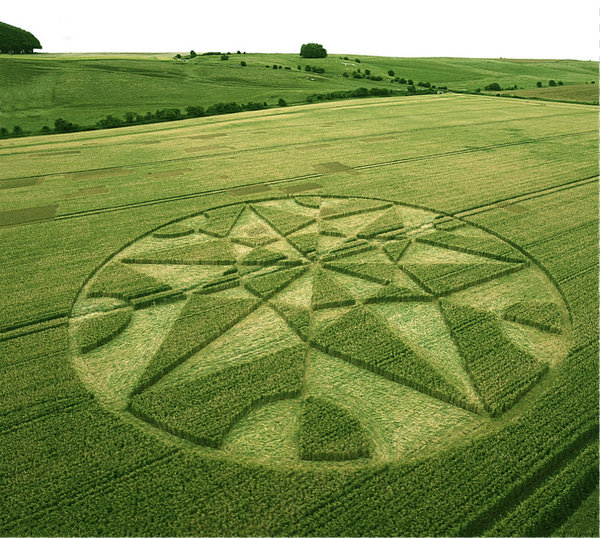
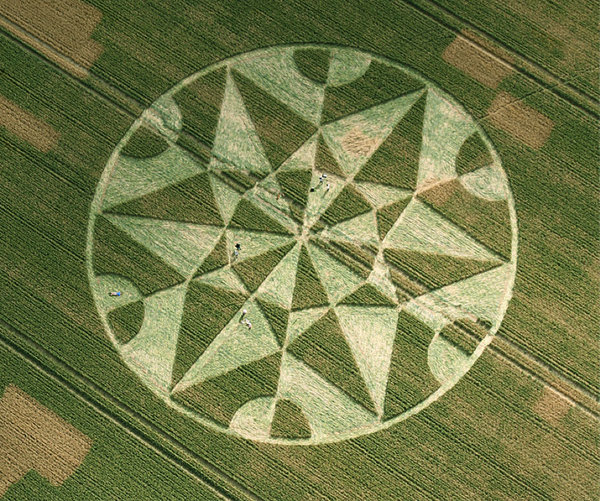

Healing Circles?
Each year I take two crop circle tours with a limited number of people which always seem to be fully booked and immensely popular. On the first tour we visited the Hackpen formation. Peter Astle brought his lovely rescue dog Joey with him. Joey had clearly had a chequered history as Peter told me he was very 'clingy', nervous about everything and would not leave his side.
However, within minutes of entering the circle he was off on his own, investigating and generally completely at ease being away from Peter who couldn’t believe his eyes. Never had Joey shown such independence before! Animals are even more sensitive in their response to the circles than most humans.

Number Crunching
Following on from this circle was a magnificent one that appeared at Cley Hill on the 18th July. It really was a stunner. It was one of the most teasing circles - a mixture of tetrahedrons and triangles. I challenge you to count the number of triangles within its perimeter. I got as far as 24 — maybe you can do better?
There is a legend attached to Cley Hill which relates that the hill was formed by the devil, when he dropped a sack of earth with which he had planned to bury the town of Devises. He had retrieved the earth from Somerset and was travelling to Devizes when he stopped to ask an old man the distance to the town. The man replied that he had been walking for years to reach Devizes, so the devil abandoned his plan.


My last flight was over the Warwickshire formation at Wooton Waven.
My Canon camera lens with autofocus and stabiliser had thankfully just come back from being repaired, but sadly it still would not focus properly so had to be returned yet again. Eventually I took it up to a professional Cannon camera repairer in London, and all is well again and ready for this coming season. I drove up to Wellesbourne in Warwickshire where HeliAir have their head office. It was a glorious morning, one of the few sunny days we have had this summer. As we will fly low, if conditions permit, the airfield has to notify and get permission from the police before taking off. I flew with a pilot with whom I had flown several years ago, so it was good to renew our acquaintance. Unlike the pilots at Thruxton, where I sit beside them in front with my door off, he liked me to sit behind him so that he could be on the same side and be able to put me in the right spot; but that presented a bit of a problem to start with as all I could see was his back!!! However, we sorted that out and all was well, and as there was no-one in the circle, or any animals anywhere, we were able to hover very low - which is always a huge help and a great excitement.
Wooton Waven has a very ancient church dating back to the 7th century and well worth a visit. The original building was probably of wood and thatch, but a stone building was soon built to replace it and survived the probable depredations of the Vikings. We don’t know the date of the Saxon tower base that forms part of the current church.

Wooton Waven is also very close to a very small tranquil village called Alveston, tucked away in the country where I lived for several years as a teenager with my parents and sister. It is close to Stratford on Avon and we were right on the doorstep of the wonderful Shakespeare plays. I remember punting on the River Avon and also visiting Charlecote, a splendid and rather grand 16th century country house, surrounded by its own deer park, on the banks of the River Avon near Wellesbourne, Warwickshire.

The crop circle season appeared to come to an end, and a rather abrupt end it seemed, with a final fling, a complex and elaborate event containing as yet still undeciphered hieroglyphics at Rochford, Essex. Sadly, I could not fly over it as the cost was beyond my purse. The last one I flew over was the Wooton Waven circle which appeared on the 7th of August.
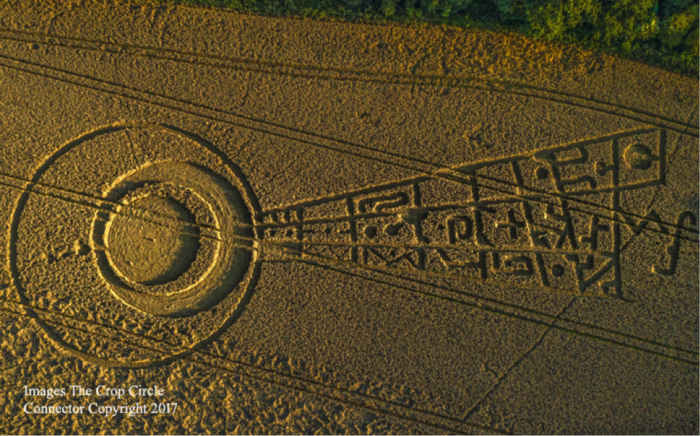
So what sort of crop circle has this been? Despite having fewer circles than usual and I am reliably informed that the last time we had so few was in 1973, we have had some extremely interesting, complex and beautiful ones. However despite all gloomy forecasts many new countries are showing enormous interest in the subject — maybe the circles take some time to pierce the consciousness into awareness and activity. This is a phenomenon that appears to respond not only to the interest shown but to fascination and passion awakened by its presence.
I am deeply grateful to Paul Gerry and Hazel Drummond for their unstinting help and dedication with and to our continuing research and to the people who annually contribute as guinea pigs.
Also to James Hussey and all the other the farmers who kindly allow us to go into their fields. We must not forget that the crops are the farmers’ livelihood and that permission should be sought and obtained before going on to their land.
Thanks also to the expert pilots Shaun Byam, Dan Taylor and others at HeliAir who with their skill and prowess allow me to take wonderful photographs.
Finally, last but certainly by no means least, to Steve my expert web manager who nobly continues to look after my web site and shows marvellous patience with my idiosyncrasies.










